
Barnacles are a type of arthropod constituting the subclass Cirripedia in the subphylum Crustacea, and are hence related to crabs and lobsters. Barnacles are exclusively marine, and tend to live in shallow and tidal waters, typically in erosive settings. They are sessile (nonmobile) and most are suspension feeders, but those in infraclass Rhizocephala are highly specialized parasites on crustaceans. They have four nektonic larval stages. Around 1,000 barnacle species are currently known. The name Cirripedia is Latin, meaning "curl-footed". The study of barnacles is called cirripedology.
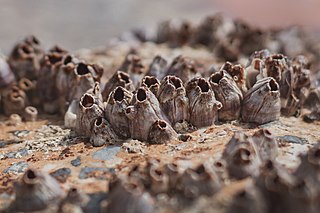
Balanus is a genus of barnacles in the family Balanidae of the subphylum Crustacea.

Thoracica is an infraclass of crustaceans which contains the most familiar species of barnacles found on rocky coasts, such as Semibalanus balanoides and Chthamalus stellatus. They have six well-developed limbs, and may be either stalked or sessile. The carapace is heavily calcified. The group includes free-living and commensal species.

Thecostraca is a class of marine invertebrates containing over 2,200 described species. Many species have planktonic larvae which become sessile or parasitic as adults.

Megabalanus is a genus of barnacles in the family Balanidae. Members of the genus grow to 7 cm (2.8 in) in length and inhabit the lower intertidal zone.

Chthamalus is a genus of barnacles that is found along almost all non-boreal coasts of the northern hemisphere, as well as many regions in the southern hemisphere. These small barnacles have been studied in part because of the taxonomic confusion over a group of species that, by and large, are morphologically and ecologically quite similar. In recent years, molecular techniques have identified a number of cryptic species that have been subsequently confirmed by taxonomists using morphological measurements. Most recently the genus has been shown to be paraphyletic, with the genus Microeuraphia nested within Chthamalus.

Concavus is a genus of barnacles.

Coronula is a genus of whale barnacles, containing the following species :
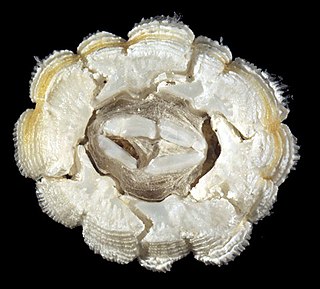
Platylepas is a genus of barnacles in the family Platylepadidae of the subphylum Crustacea.
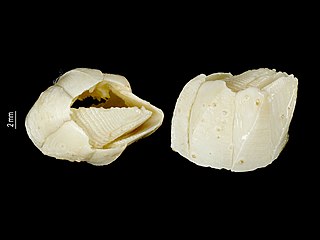
Pachylasmatidae is a family of symmetrical sessile barnacles in the order Balanomorpha. There are about 10 genera and at least 30 described species in Pachylasmatidae.
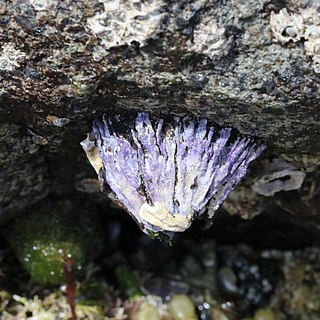
Austrobalanus is a genus of symmetrical sessile barnacles in the family Austrobalanidae, the sole genus of the family. There are at least three described species in Austrobalanus.

Verrucomorpha is an order of asymmetrical sessile barnacles in the class Thecostraca. They are typically found in deeper and deep-sea habitats. There are 2 families and more than 100 described species in Verrucomorpha.

Epopella plicata is a species of symmetrical sessile barnacle in the family Tetraclitidae. It is found in New Zealand.

Epopella simplex is a species of symmetrical sessile barnacle in the family Tetraclitidae.

Jehlius is a genus of star barnacles in the family Chthamalidae. There are at least two described species in Jehlius.
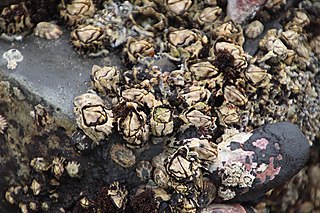
Octomeris is a genus of star barnacles in the family Chthamalidae. There are at least three described species in Octomeris.
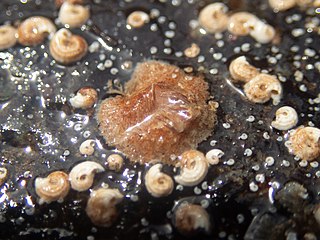
Verruca is a genus of asymmetrical sessile barnacles in the family Verrucidae. There are about 20 described species in Verruca, around half of them extinct.

Notomegabalanus is a genus of acorn barnacles in the family Balanidae. There are about 12 described species in Notomegabalanus.
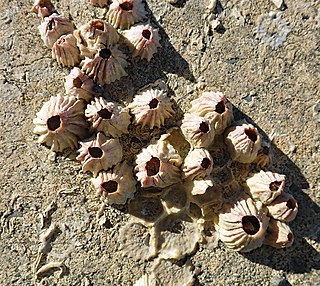
Notobalanus is a genus of acorn barnacles in the family Balanidae. There are at least two described species in Notobalanus.


















